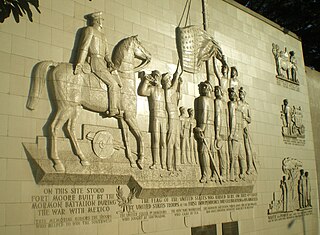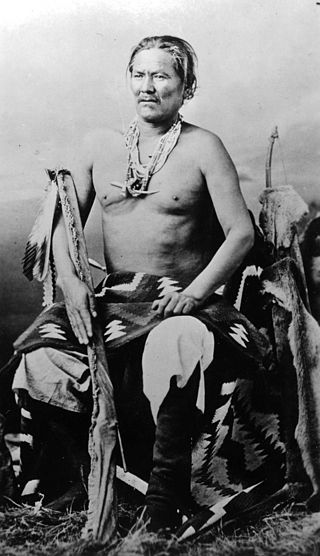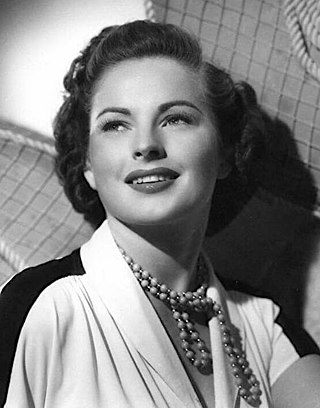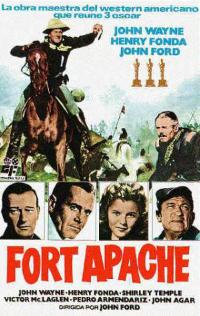
Gerónimo was a military leader and medicine man from the Bedonkohe band of the Ndendahe Apache people. From 1850 to 1886, Geronimo joined with members of three other Central Apache bands – the Tchihende, the Tsokanende and the Nednhi – to carry out numerous raids, as well as fight against Mexican and U.S. military campaigns in the northern Mexico states of Chihuahua and Sonora and in the southwestern American territories of New Mexico and Arizona.

George R. Crook was a career United States Army officer who served in the American Civil War and the Indian Wars. He is best known for commanding U.S. forces in the 1886 campaign that led to the defeat of the Apache leader Geronimo. As a result, the Apache nicknamed Crook Nantan Lupan, which means "Grey Wolf."

The Mormon Battalion was the only religious unit in United States military history in federal service, recruited solely from one religious body and having a religious title as the unit designation. The volunteers served from July 1846 to July 1847 during the Mexican–American War of 1846–1848. The battalion was a volunteer unit of between 534 and 559 Latter-day Saint men, led by Mormon company officers commanded by regular U.S. Army officers. During its service, the battalion made a grueling march of nearly 1,950 miles from Council Bluffs, Iowa, to San Diego, California.

Wardell Edwin Bond was an American film character actor who appeared in more than 200 films and starred in the NBC television series Wagon Train from 1957 to 1960. Among his best-remembered roles are Bert the cop in Frank Capra's It's a Wonderful Life (1946) and Captain Clayton in John Ford's The Searchers (1956). As a character actor, Bond frequently played cowboys, cops and soldiers.

William Reginald Gardiner was an English actor on the stage, in films and on television.

Rio Grande is a 1950 American romantic Western film directed by John Ford and starring John Wayne and Maureen O'Hara. It is the third installment of Ford's "Cavalry Trilogy", following two RKO Pictures releases: Fort Apache (1948) and She Wore a Yellow Ribbon (1949). Wayne plays the lead in all three films, as Captain Kirby York in Fort Apache, then as Captain Nathan Brittles in She Wore a Yellow Ribbon, and finally as a promoted Lieutenant Colonel Kirby Yorke in Rio Grande. Rio Grande's supporting cast features Ben Johnson, Claude Jarman Jr., Harry Carey Jr., Chill Wills, J. Carrol Naish, Victor McLaglen, Grant Withers, the Western singing group the Sons of the Pioneers and Stan Jones.

The Apache Wars were a series of armed conflicts between the United States Army and various Apache tribal confederations fought in the southwest between 1849 and 1886, though minor hostilities continued until as late as 1924. After the Mexican–American War in 1846, the United States annexed conflicted territory from Mexico which was the home of both settlers and Apache tribes. Conflicts continued as American settlers came into traditional Apache lands to raise livestock and crops and to mine minerals.

The term Navajo Wars covers at least three distinct periods of conflict in the American West: the Navajo against the Spanish ; the Navajo against the Mexican government ; and the Navajo against the United States. These conflicts ranged from small-scale raiding to large expeditions mounted by governments into territory controlled by the Navajo. The Navajo Wars also encompass the widespread raiding that took place throughout the period; the Navajo raided other tribes and nearby settlements, who in return raided into Navajo territory, creating a cycle of raiding that perpetuated the conflict.

The Powder River Expedition of 1865 also known as the Powder River War or Powder River Invasion, was a large and far-flung military operation of the United States Army against the Lakota Sioux, Cheyenne, and Arapaho Indians in Montana Territory and Dakota Territory. Although soldiers destroyed one Arapaho village and established Fort Connor to protect gold miners on the Bozeman Trail, the expedition is considered a failure because it failed to defeat or intimidate the Indians.

Richard Egan was an American actor. After beginning his career in 1949, he subsequently won a Golden Globe Award for his performances in the films The Glory Brigade (1953) and The Kid from Left Field (1953). He went on to star in many films such as Underwater! (1955), Seven Cities of Gold (1955), The Revolt of Mamie Stover (1956), Love Me Tender (1956), Tension at Table Rock (1956), A Summer Place (1959), Esther and the King (1960) and The 300 Spartans (1962).

Benjamin Franklin "Frank" McGrath was an American television and film actor and stunt performer who played the comical, optimistic cook with the white beard, Charlie B. Wooster, on the western series Wagon Train for five seasons on NBC and then three seasons on ABC. McGrath appeared in all 272 episodes in the eight seasons of the series, which had ended its run only two years before his death. McGrath's Wooster character hence provided the meals and companionship for both fictional trail masters, Ward Bond as Seth Adams and John McIntire as Christopher "Chris" Hale.

The Cherokee Trail was a historic overland trail through the present-day U.S. states of Oklahoma, Kansas, Colorado, and Wyoming that was used from the late 1840s up through the early 1890s. The route was established in 1849 by a wagon train headed to the gold fields in California. Among the members of the expedition were a group of Cherokee. When the train formed in Indian Territory, Lewis Evans of Evansville, Arkansas, was elected Captain. Thus, this expedition is sometimes written as the Evans/Cherokee Train. In 1850 four wagon trains turned west on the Laramie Plains, along Wyoming's southern border to Fort Bridger.

Coleen Gray was an American actress. She was best known for her roles in the films Nightmare Alley (1947), Red River (1948), and Stanley Kubrick's The Killing (1956).

Meeker Massacre, or Meeker Incident, White River War, Ute War, or the Ute Campaign), took place on September 29, 1879 in Colorado. Members of a band of Ute Indians attacked the Indian agency on their reservation, killing the Indian agent Nathan Meeker and his 10 male employees and taking five women and children as hostages. Meeker had been attempting to convert the Utes to Christianity, to make them farmers, and to prevent them from following their nomadic culture. On the same day as the massacre, United States Army forces were en route to the Agency from Fort Steele in Wyoming due to threats against Meeker. The Utes attacked U.S. troops led by Major Thomas T. Thornburgh at Milk Creek, 18 mi (29 km) north of present day Meeker, Colorado. They killed the major and 13 troops. Relief troops were called in and the Utes dispersed.

Fort Apache is a 1948 American Western film directed by John Ford and starring John Wayne and Henry Fonda. The film was the first of the director's "Cavalry Trilogy" and was followed by She Wore a Yellow Ribbon (1949) and Rio Grande (1950), both also starring Wayne. The screenplay was inspired by James Warner Bellah's short story "Massacre" (1947). The historical sources for "Massacre" have been attributed both to George Armstrong Custer and the Battle of Little Bighorn and to the Fetterman Fight.

Willard Parker was an American film and television actor. He starred in the TV series Tales of the Texas Rangers (1955–1958).

Lafayette Head was the first Lieutenant Governor of Colorado, serving from 1876 to 1879 under Governor John Long Routt.

A Distant Trumpet is a 1964 American Western film, the last directed by Raoul Walsh. It stars Troy Donahue, Suzanne Pleshette and Diane McBain.

The Department of Oregon was one of two Army Departments created September 13, 1858, replacing the original Department of the Pacific and was composed of the Territories of Washington and Oregon, except the Rogue River and Umpqua Districts, which were assigned to the Department of California. Its creation was authorized by General Orders, No. 10, of the United States Department of War, Adjutant-General's Office, September 13, 1858. Its headquarters was at Fort Vancouver, in the Washington Territory.
The Second Battle of Cabin Creek was part of a plan conceived by Confederate Brigadier General Stand Watie, who had been promoted from colonel after the First Battle of Cabin Creek. The plan was to have a Confederate force attack central Kansas from Indian Territory, raiding Union Army facilities and encouraging Indian tribes in Western Kansas to join in an attack on the eastern part of the state. Watie presented the plan to his superior, General S. B. Maxey on February 5, 1864. Maxey approved the plan on the condition that the attack would start by October 1, to coincide with an attack on Missouri already planned by General Sterling Price.




















